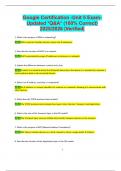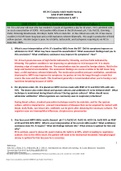Exam (elaborations)
Google Certification -Unit 5 Exam- Updated *Q&A* (100% Correct) 2025/2026 |Verified|
- Course
- Institution
Google Certification -Unit 5 Exam- Updated *Q&A* (100% Correct) 2025/2026 |Verified| 1. What is the purpose of DNS in networking? DNS is used to translate domain names into IP addresses. 2. Describe the function of DHCP in a network. DHCP automatically assigns IP addresses to device...
[Show more]





